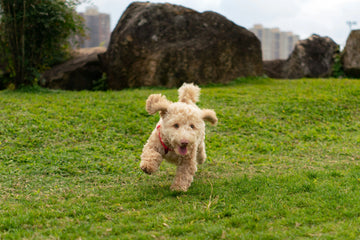"Recently, my chihuahua seems reluctant to climb stairs, and her walking is unsteady..."
"My beagle has been lying down a lot lately, and his hind legs seem weak..."
Many dog owners have encountered similar concerns. It's heartbreaking to see your once energetic pet suddenly become less mobile. Don't worry - today we'll discuss the issue of hind leg weakness in dogs, covering everything from identifying symptoms to treatment options, helping you understand how to care for your sick furry friend.

I. How to Identify Hind Leg Weakness in Dogs?
Watch for these symptoms: Your dog might be unusually slow getting up, show obvious weakness in their hind legs, or drag their feet while walking. Sometimes, they might suddenly sit down as if they can't continue walking. In more severe cases, they might be unable to stand or show significant unsteadiness while walking.
 II. Three Most Common Causes of Hind Leg Weakness in Dogs
II. Three Most Common Causes of Hind Leg Weakness in Dogs
1. Arthritis
This is one of the most common causes, especially in senior or overweight dogs. Similar to human arthritis, dogs' joints can become inflamed and painful due to long-term wear and tear. They may become reluctant to move and struggle to stand up or lie down. This condition typically develops gradually.
2. Intervertebral Disc Disease
This condition is common in small breeds like Dachshunds and Poodles, though it can affect larger breeds too. When a disc herniates and puts pressure on the nerves, dogs may suddenly develop hind leg weakness, potentially leading to paralysis in severe cases. Immediate veterinary attention is necessary if your dog suddenly can't stand.
3. Hip Problems
Particularly common in large breeds, hip dysplasia is a hereditary condition. Affected dogs may show signs of unsteady walking, hind leg weakness, and muscle atrophy. These symptoms often worsen with age.

III. How to Help Dogs with Hind Leg Weakness?
The first priority when noticing hind leg weakness is to seek veterinary care for a thorough examination. Veterinarians will use physical examinations, X-rays, MRI, and other diagnostic tools to determine the specific cause. After diagnosis, we can help dogs recover through several approaches:
1. Lifestyle Adjustments
Dogs with hind leg weakness need a safer, more accommodating environment. Here are specific recommendations:
- Home Environment Modification: Install non-slip mats on wooden floors and tiles, especially in areas where your dog frequently moves. Add anti-slip strips on stairs to prevent accidents.

- Mobility Aid Usage: Select appropriate rear support harnesses to help dogs maintain balance and reduce strain on hind legs, making it easier for them to navigate stairs and get in/out of cars.
- Sleep Area Modification: Provide a bed with appropriate height and firmness, preferably memory foam, to reduce joint pressure and make getting up and down easier.
- Activity Area Management: Designate safe activity zones, remove potential tripping hazards, and use gates when necessary to prevent accidents.
2. Medical Treatment
Depending on the underlying cause, veterinarians will prescribe appropriate medication:
- Anti-inflammatory and Pain Medication: Helps relieve pain and inflammation from conditions like arthritis, improving mobility. Use as prescribed to avoid gastric issues.
- Neurological Medication: May be needed for nerve-related issues like disc herniation to improve nerve function and promote recovery.
- Hormone Therapy: Some autoimmune conditions may require hormone treatment, but strict adherence to veterinary guidance and regular check-ups are essential.
- Nutritional Supplements: Supplements like glucosamine and chondroitin may be recommended to help repair and protect joints.
3. Surgical Treatment
For severe cases, surgery might be necessary:
- Disc Herniation: Surgery may be required to relieve nerve pressure when conservative treatment fails.
- Hip Problems: Severe hip dysplasia might need surgical intervention to improve joint structure and quality of life.
- Orthopedic Injuries: Fractures and other trauma may require surgical fixation, followed by careful wound care and gradual rehabilitation.

4. Dietary Adjustments
Proper diet management is crucial for recovery:
- Weight Control: Develop a scientific feeding plan to avoid overfeeding. Excess weight increases joint stress and impacts recovery.
- Balanced Nutrition: Ensure adequate intake of protein, vitamins, and minerals to support recovery.
- Nutritional Supplements: Add appropriate supplements like calcium and vitamins under veterinary guidance.

IV. Frequently Asked Questions
Q1: Should I seek immediate veterinary care for hind leg weakness?
A: For sudden onset weakness, immediate veterinary care is recommended. For gradually developing mild symptoms, schedule a veterinary appointment soon but don't panic. Immediate care is essential if accompanied by severe pain, paralysis, or loss of bowel/bladder control.
Q2: Is hind leg weakness normal in senior dogs?
A: While more common in senior dogs, it's not a "normal aging" process but rather a sign of potential health issues. Timely veterinary care and appropriate intervention can significantly improve senior dogs' quality of life.
Q3: How long does recovery take after surgery?
A: Recovery time varies depending on the cause and type of surgery, ranging from weeks to months. Following post-operative care instructions and rehabilitation protocols is crucial - don't rush the process.

Remember, hind leg problems in dogs can't be simply explained away as "getting old." Like caring for family members, we need to observe carefully and address issues promptly. With proper diagnosis and attentive care, our furry friends can regain their mobility and joy.
After all, nothing brings more joy than seeing our dogs healthy again, running happily in the sunshine. Let's work together to give our dogs the best care possible!





